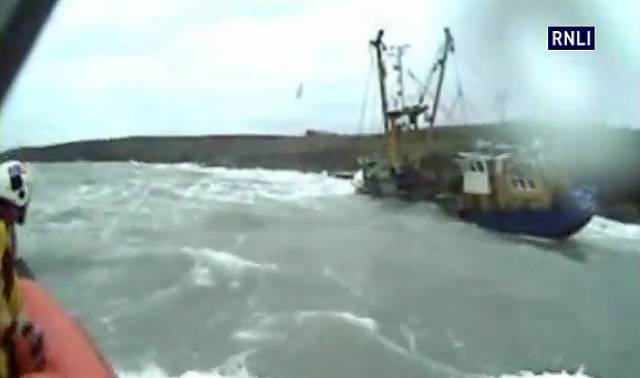Three fishermen were rescued tonight (Sunday 10 April) in gale force conditions by volunteer lifeboat crew from Kinsale RNLI. The 20 metre beam trawler was forced onto the rocks at Moneypoint, at the entrance to Kinsale harbour, around 1800hrs this evening. See Video below.
Kinsale RNLI was launched at 6.10pm and arrived on scene less than five minutes later to find the vessel on the rocks with three-metre high waves breaking over its deck. The experienced lifeboat crew, led by Helm Nick Searls, dropped anchor and veered down, getting within feet of the stricken boat. The three crewmen then entered the water individually and were pulled to safety on board the RNLI lifeboat.
They were brought to Kinsale RNLI station where they were shaken by their ordeal but uninjured. The RNLI lifeboat returned to the scene to monitor the vessel and to ensure the safety of members of the public who lined the shore to watch the incident unfold. With the arrival of the local Coast Guard on the shoreline, the RNLI lifeboat returned to the station.
Kinsale RNLI Helm Nick Searls said: ‘Our priority was to get the crew safely off the trawler, which was complicated by the breaking waves coming over the top of the boat. We needed to manoeuvre the lifeboat in as close as possible to the stricken trawler so that the three fishermen could individually jump into the water to be recovered immediately by the lifeboat crew. The fishermen were wearing lifejackets and the operation to recover all three of them onto the lifeboat was successful.’
The three rescued men lost all their personal belongings and RNLI volunteers issued an appeal to the local community in Kinsale for clothing and shoes for the men. The station also received several offers of accommodation.































































